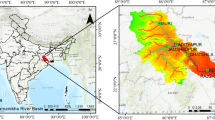Abstract
A brief description is given for the natural conditions and economic activity on a local drainage basin of the Cheboksary Reservoir (less the Oka Basin). The main principles of a new version of landscape-hydrological method used to evaluate nutrient runoff from the drainage basin into water bodies are given. The article presents the values of the runoff of these elements into the Cheboksary Reservoir calculated taking into account the effect of the drainage basin and anthropogenic load from mineral and organic fertilizers applied on agricultural fields and the input of wastes onto the drainage basin from the population that have no access to sewage system.










Similar content being viewed by others
REFERENCES
Avandeeva, O.P., Methodological aspects of water quality monitoring for zones of higher environmental risk of oil-induced pollution: case study of the Cheboksary Reservoir, Cand. Sci. (Geogr.) Dissertation, Moscow: Water Problems Institute, Russian Academy of Sciences, 2015.
Avtomatizirovannaya informatsionnaya sistema gosudarstvennogo monitoringa vodnykh ob’’ektov (AIS GM-VO) (Automated Information System of State Monitoring of Water Objects), [Electronic resource]. URL: https://gmvo.skniivh.ru/. Accessed May 10, 2020.
Bobrovitskaya, N.N., Studies and calculation of soil washout from slopes, in Sb. rabot po gidrologii (Coll. Pap. in Hydrology), Leningrad: Gidrometeoizdat, 1977, no. 12, pp. 93–99.
Briukhanov, A.Yu., Kondrat’ev, S.A., Oblomkova, N.S., Ogluzdin, A.S., and Subbotin, I.A., Method for determining biogenic load onto water bodies from agricultural production, Tekhnologii i tekhnicheskie sredstva mekhanizirovannogo proizvodstva produktsii rastenievodstva i zhivotnovodstva (Technologies and Engineering Means for Mechanized Processing of Plant and Animal Products), 2016, no. 89, pp. 175–183.
Vserossiiskaya sel’skokhozyaistvennaya perepis’ 2016 goda (All-Russian Rural Population Census) [Electronic Resource]. URL: https://www.gks.ru/519. Accessed May 10, 2020.
Golosov, V.N., Erosion-accumulation processes in the upper links of fluvial network in developed plains of moderate zone, Extended Abstract of Doctoral (Geogr.) Dissertation, Moscow: Moscow State University, 2003.
Edinyi gosudarstvennyi reestr pochvennykh resursov Rossii. 2014 (Unified State Register of Soil Resources in Russia) [Electronic resource]. URL: http://egrpr.soil.msu.ru/index.php. Accessed April 10, 2020.
Kondrat’ev, S.A., Briukhanov, A.Yu., and Terekhov, A.V., The structure of catchment surface as a factor governing nutrient load onto a water body (based on data of mathematical simulation), Vopr. Geogr., 2018, no. 145, pp. 89–108.
Kondrat’ev, S.A. and Shmakova, M.V., Matematicheskoe modelirovanie massoperenosa v sisteme “vodosbor-vodotok-vodoem” (Mathematical Simulation of Mass Transport in the System “Drainage Basin—Stream—Water Body”), St. Petersburg: Nestor-Istoriya, 2019.
Koronkevich, N.I., Vodnyi balans Russkoi ravniny i ego antropogennye izmeneniya (Water Balance of the Russian Plain and its Anthropogenic Changes), Moscow: Nauka, 1990.
Litvin, L.F., Golosov, V.N., Dobrovol’skaya, N.G., Ivanova, N.N., Kiryukhina, Z.P., and Krasnov, S.F., Stationary studies of soil erosion during snow melting in the Central Chernozem Region, Eroziya pochv i ruslovye protsessy (Soil Erosion and Channel Processes), no. 11, Chalov, R.S., Ed., Moscow: Mosk. Gos. Univ., 1998.
Naselenie. Operativnaya informatsiya. Territorial’nyi organ Federal’noi sluzhby gosudarstvennoi statistiki po Nizhegorodskoi oblasti (Population. Current Information. Territorial Body of Federal Statistical Service for Nizhegorodskaya oblast) [Electronic resource]. URL: https://nizhstat.gks.ru/folder/33271. Accessed April 10, 2020.
O natsional’nykh tselyakh i strategicheskikh zadachakh razvitiya Rossiiskoi Federatsii na period do 2024 g. (National Targets and Strategic Tasks of Russian Federation Development up to 2024), Presidential Edict of May 7, 2018.
Otsenka reguliruyushchego vozdeistviya (Assessment of Regulation Effect) [Electronic Resource]. http://orv.gov.ru/Regions/Details/34. Accessed April 10, 2020.
Khrisanov, N.I. and Osipov, G.K., Upravlenie evtrofirovaniem vodoemov (Management of Eutrophication of Water Bodies), St. Petersburg: Gidrometeoizdat, 1993.
Yasinskii, S.V., Venitsianov, E.V., and Vishnevskaya, I.A., Diffuse pollution of water bodies and estimation of export of biogenic elements under different scenarios of water use in the watershed, Water Resour., 2019, vol. 46, no. 2, pp. 266–277.
Yasinskii, S.V., Gurov, F.N., and Shil’krot, G.S., Method for evaluating nutrient input into ravine and river network of a small river, Izv. Ross. Aakad. Nauk, Ser. geograf., 2007, no. 4, pp. 44–53.
Yasinskii, S.V., Kashutina, E.A., Sidorova, M.V., and Narykov, A.N., Anthropogenic load onto a drainage basin and its incorporation into the estimate of nutrient input into a large water body: case study of the Cheboksary Reservoir, Nauchnye problemy ozdorovleniya rossiiskikh rek i puti ikh resheniya (Scientific Problems of Restoration of Russian Rivers and Ways to Their Solution), Coll. Sci. Pap., Nizhny Novgorod: Studiya F1, pp. 487–491.
Behrendt, H. and Dannowski, R., Nutrients and Heavy Metals in the Odra River System: Emissions from Point and Diffuse Sources, Their Loads, and Scenario Calculations on Possible Change, Berlin: Weissensee Verlag Publ., 2005.
Behrendt, H. and Opitz, D., Retention of nutrients in river systems: dependence on specific runoff and hydraulic load, Hydrobiologia, 1999, vol. 410, pp. 111–122.
HELCOM Guidelines for the Compilation of Waterborne Pollution to the Baltic Sea (PLC-water), Helsinki: HELCOM, 2005.
Funding
This study was carried out under governmental order (subject no. 0148-2019-0007/АААА-А19-119021990093-8).
Author information
Authors and Affiliations
Corresponding author
Additional information
Translated by G. Krichevets
Rights and permissions
About this article
Cite this article
Yasinskii, S.V., Kashutina, E.A., Sidorova, M.V. et al. Anthropogenic Load and the Effect of Drainage Area on the Diffuse Runoff of Nutrients into a Large Water Body: Case Study of the Cheboksary Reservoir. Water Resour 47, 810–827 (2020). https://doi.org/10.1134/S009780782005022X
Received:
Revised:
Accepted:
Published:
Issue Date:
DOI: https://doi.org/10.1134/S009780782005022X




